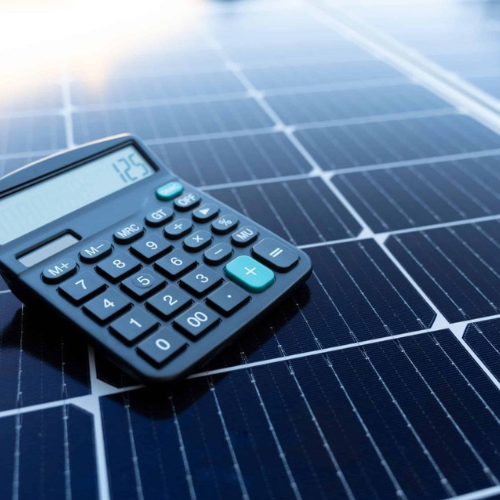Contents
- 1 Understanding Solar Energy ROI
- 2 Factors Affecting Solar Energy ROI
- 3 How to Calculate Solar Energy ROI
- 4 Real-Life Examples of Solar Energy Return on Investment (ROI)
- 5 Maximizing Solar Energy ROI and Project Feasibility
- 6 Frequently Asked Questions About Solar Energy ROI
- 6.1 What is a Solar Energy ROI Calculator and how does it work?
- 6.2 What are some examples of using a Solar Energy Return on Investment (ROI) Calculator in project analysis?
- 6.3 How accurate are Solar Energy ROI Calculator results?
- 6.4 What factors are included in a Solar Energy ROI Calculator?
- 6.5 Can a Solar Energy ROI Calculator be used for all solar projects?
- 6.6 What are the benefits of using a Solar Energy ROI Calculator?
In today’s world, investing in solar energy isn’t just about being eco-friendly; it’s actually a smart financial move for you.
Understanding Solar Energy Return on Investment (ROI), along with conducting an energy audit, is key if you’re thinking about making this sustainable choice. This article will break down what ROI means, discuss solar technology trends, and explain why it’s important for you. It’ll explore the factors that influence your solar investment, from initial installation costs to long-term energy cost savings, and guide you through calculating your potential returns using an ROI calculator.
With real-life examples, cost-benefit analysis, and tips to help you get the most out of your solar energy investment, you’ll be fully equipped to make informed decisions about leveraging the capabilities of the sun.
Understanding Solar Energy ROI

Understanding the ROI of solar energy is essential in today’s world, where renewable energy is key to achieving energy independence and sustainability. Return on investment (ROI) is a financial metric used to evaluate the profitability of an investment.
By diving into the return on investment (ROI) linked to solar panels, you can uncover potential financial benefits, energy savings, and the long-term economic viability of renewable energy projects.
Solar energy doesn’t just help you cut down on utility bills; it also comes with tax incentives and government rebates that can really boost your investment analysis.
Whether you’re thinking about installing solar for your home or a commercial property, grasping the basics of energy efficiency, solar panel efficiency, and ROI can really give power to your decision-making process.
Barbose, G., Darghouth, N., Millstein, D., Spears, M., Wiser, R., Buckley, M., Widiss, R., & Grue, N. (2016). Tracking the Sun: Installed Price Trends for Distributed Photovoltaic Systems in the United States. Lawrence Berkeley National Laboratory. Link
What is ROI and Why is it Important?
ROI, or return on investment, is a financial metric that helps you figure out how profitable your investment is, especially when it comes to solar energy. It breaks down the relationship between what you spend on solar installation and the returns you can expect, which might include energy savings, tax credits, and solar incentives, enhancing the overall return analysis. Understanding ROI is crucial because it helps you make smart investment choices based on the expected cash flow, financial returns, and long-term savings over the life of your solar panels.
To calculate ROI, you’ll need to look at both the initial costs of solar equipment and installation, as well as the projected savings on your utility bills. This can really improve the financial outlook, whether you’re a homeowner or running a commercial operation, ensuring the financial viability of your solar energy investment.
Plus, there are some current solar incentives to consider, like federal and state tax credits, rebates, and net metering policies. These can significantly enhance the overall cost savings and financial forecasting tied to solar investments. They not only lower your upfront expenses but also boost your long-term financial returns and cash savings, making solar energy an increasingly appealing option for various types of investors.
Factors Affecting Solar Energy ROI
When you’re thinking about solar energy, there are a few key factors that can really impact the ROI of your investment and the overall project feasibility. You’ll want to pay attention to things like the initial installation costs of solar panels, how efficient the photovoltaic systems are, and what ongoing maintenance costs you might face.
All of these components play a big role in how much energy you can produce, your energy generation, and how much you’ll save. Plus, keep an eye on electricity rates, efficiency ratios, and any available solar incentives, as they can either boost or hurt your return on investment.
Conducting a thorough cost analysis and financial metrics evaluation is crucial before proceeding with a solar installation.
Initial Investment Costs
The initial investment costs associated with solar panels can really shape the overall ROI of your solar energy project and influence your investment returns analysis. These upfront costs include the price of the photovoltaic systems, installation fees, and any solar financing options you decide to explore. It’s super important to get a handle on these details because they lay the groundwork for your investment analysis, helping you weigh the potential long-term savings and financial returns against your capital investment.
Beyond these main expenses, you’ll also want to consider other factors that can vary, like the quality of materials, inverter costs, and permit fees, all of which can affect your total spending and project profitability.
Different financing options—such as solar loans, leases, or power purchase agreements—can also impact your cash flow and project analysis. This gives you some flexibility in how you allocate your capital and ultimately influences the net gains from the project.
A well-structured financing plan isn’t just about making it affordable right off the bat; it can also set you up for a much better ROI trajectory and improve the economic analysis of your investment. With the right plan, you could enjoy accelerated payback periods that make your solar initiatives even more financially viable and enhance the project ROI.
Energy Production and Savings
Energy production and savings are key when you’re looking to evaluate the ROI and financial returns of your solar energy investment. By measuring how much energy your solar panels generate in kilowatt-hours, you can actually see your energy savings, offset costs, and get a feel for how well your solar setup is performing. This data not only helps you understand the financial return and project feasibility but also gives you insight into the sustainability and efficiency of your energy use.
When calculating energy production, keep in mind factors like your location, seasonal changes, and how your panels are oriented—all of these can impact how much energy you get and influence your energy payback time. Performance metrics like capacity factor and system efficiency will give you a clearer picture of how well your system is meeting your energy needs and contributing to your energy cost savings, whether it’s for your home or business.
- Your location
- Seasonal changes
- How your panels are oriented
Don’t overlook net metering and other solar incentives, either. It’s a game changer for optimizing your savings because it lets you send any excess energy back to the grid for credits, which helps lower your overall utility bills. Understanding all these elements is crucial for maximizing the benefits of solar energy and making sure you reap those long-term financial rewards.
Maintenance and Long-term Costs
Maintenance and long-term costs are critical factors to consider when you’re figuring out the ROI of solar energy systems and the financial indicators of your investment. While solar panels usually don’t require much upkeep, it’s important to understand the operational costs and potential depreciation to get a complete picture of your finances and financial forecasting. These factors can really shape your long-term savings strategy and the overall financial viability of your solar investment, so make sure to include them in your financial calculations.
Typically, maintenance costs for solar installations can vary from minimal routine checks to unexpected repairs that might sneak up on you over time due to wear and tear or environmental factors. These costs should be factored into your solar asset management. That’s why it’s crucial to anticipate these expenses in your overall budget and amortization plan.
To keep your system running smoothly, here are some best practices you want to follow:
Here are some factors to consider:
- Regularly clean the panels
- Schedule periodic inspections with qualified technicians
- Monitor system output so you can catch any efficiency drops early on
When you take these maintenance strategies into account for your long-term ROI calculations, you’ll get a much clearer picture of the financial implications of owning a solar energy system and its sustainability metrics. This will help you make more informed decisions about your future investments.
How to Calculate Solar Energy ROI
Calculating your solar energy ROI is all about taking a systematic approach and understanding the investment appraisal process. You can use a solar energy calculator or an investment returns calculator to assess different financial elements.
This process helps you estimate the potential payback period for your solar energy investment and projects how much you’ll save on energy-related expenses over time.
By using a savings calculator, you can easily compare your initial costs with the long-term financial benefits and solar cash flows, helping you make informed investment decisions.
Step-by-Step Guide
To effectively calculate your solar energy ROI, just follow this step-by-step guide that breaks down the essential components, financial indicators, and calculations you’ll need.
Start by gathering all the data on your upfront costs, which includes solar installation and any financing options, ensuring a thorough cost-benefit analysis. Then, analyze your expected energy production and savings using ROI metrics and other performance analysis tools. This structured approach will give you a solid assessment of your investment payback and help strengthen your financial modeling.
Once you have compiled that initial financial data, it is important to think about your local energy rates, energy trends, and any potential annual increases, since these will really impact your savings calculations.
Next, explore some online solar calculators to estimate your system’s energy output based on your location and panel specifications, enhancing your project analysis.
As you project your long-term savings, don’t forget to factor in any government incentives, solar policy, or rebates that could boost your overall return. Engaging with community forums or talking to professional consultants can further sharpen your understanding, giving you insights into real-life applications and user experiences, which will help you make a more informed investment decision based on the current investment landscape.
Real-Life Examples of Solar Energy Return on Investment (ROI)

Looking at real-life examples of solar energy ROI can give you some great insights into how profitable and feasible solar investments really are, highlighting the overall solar value proposition.
By diving into these case studies, you’ll see how various solar projects have managed to score significant returns on investment through smart planning, efficient energy production, and taking full advantage of solar incentives and funding options.
These examples highlight the real benefits of switching to renewable energy and how it can positively affect your financial returns and environmental impact.
Case Studies: Success Stories in Solar Energy
Furthermore, case studies and success stories really shine a light on how effective solar energy can be as a solid investment option and reinforce the solar viability. By digging into specific solar projects, you’ll see how different homeowners and businesses have reaped the rewards through energy savings, solar market growth, and impressive ROI figures. These stories not only boost your confidence in solar energy but also give you a handy framework to evaluate your own potential return on investment and project profitability.
For example, a residential solar installation in California had an initial cost of about $15,000, but the homeowners recovered that within five years through lower utility bills, enjoying a fantastic 80% cut in energy costs. This showcases the potential of solar ROI and long-term savings.
On the commercial side, a solar project in Texas came in at a hefty $500,000, but it is projected to save around $75,000 each year, which means a payback period of just under seven years. This highlights the importance of cost analysis and energy savings in achieving financial returns.
And when you hear testimonials from both homeowners and business owners, there’s a common theme: making the switch to solar isn’t just about the money; it’s also a commitment to sustainability, renewable energy, and caring for the environment. Exploring solar energy benefits further reinforces these points.
Maximizing Solar Energy ROI and Project Feasibility
Maximizing your solar energy ROI is all about strategic planning, financial analysis, and really knowing how to make the most of your investment.
By utilizing available solar incentives, tax credits, and energy efficiency measures, you can boost your overall financial return and economic viability.
It’s crucial for you to explore all your solar financing options, conduct investment appraisal, and stay updated on energy trends that could impact the profitability of your solar projects.
Tips for Optimizing Your Investment
To optimize your solar investment efficiently, focus on practical tips that boost energy efficiency and financial returns. Think about exploring different solar financing options that fit your budget and investment strategy, including evaluating photovoltaic systems and installation returns.
Keeping an eye on your solar energy system’s performance helps you spot areas for improvement and maximize those savings.
Using solar technology that enables you to track energy production in real-time can make this process a breeze, enabling you to make smart, data-driven decisions. Periodic evaluations and tweaks to your solar panel configurations can improve sunlight exposure, leading to even greater energy output and efficiency ratios.
It’s smart to stay updated on potential upgrades in solar technology, as these can further enhance efficiency.
Plus, understanding the financing options available—like loans, leases, and power purchase agreements—can ease financial stress and make your transition to solar a lot smoother, enhancing your solar value proposition.
By employing these strategies, you’ll ensure a reliable and cost-effective solar energy system that meets your current and future needs, supporting energy independence and project profitability.
Frequently Asked Questions About Solar Energy ROI

What is a Solar Energy ROI Calculator and how does it work?
A Solar Energy Return on Investment (ROI) Calculator is a tool that helps individuals or businesses estimate the financial benefits of investing in solar energy. It takes into account factors such as installation costs, energy savings, and tax incentives to calculate the return on investment over a specified period of time. This aids in financial forecasting.
What are some examples of using a Solar Energy Return on Investment (ROI) Calculator in project analysis?
Some examples of using a Solar Energy Return on Investment (ROI) Calculator include calculating the ROI for a residential solar panel installation, a commercial solar energy project, or a community solar program. It can also be used to compare the ROI of different solar energy systems and evaluate solar viability.
How accurate are Solar Energy ROI Calculator results?
The accuracy of the results from a Solar Energy Return on Investment (ROI) Calculator depends on the accuracy of the information entered into the calculator. If the data is entered correctly and the calculator uses up-to-date industry standards, the results should be relatively accurate. Using reliable data is essential for accuracy, supporting performance analysis and return analysis.
What factors are included in a Solar Energy ROI Calculator?
A Solar Energy Return on Investment (ROI) Calculator include factors such as initial capital investment, expected energy production, energy prices, maintenance and operating costs, tax incentives, and financing options, all critical for project feasibility.
Can a Solar Energy ROI Calculator be used for all solar projects?
Yes, a Solar Energy Return on Investment (ROI) Calculator can be used for various types of solar energy projects, including residential, commercial, and community solar. It can also be used for both grid-tied and off-grid solar systems, aiding in renewable investment and solar cash flows analysis.
What are the benefits of using a Solar Energy ROI Calculator?
Using a Solar Energy Return on Investment (ROI) Calculator can help you make an informed decision about investing in solar energy. It can provide insight into the financial benefits and potential savings of going solar, making it easier to evaluate the feasibility of a solar energy project and assess cost reductions and energy-related expenses.







